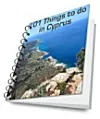Where is It in Cyprus?
by Richard W. Brown
(Malvern Worcestershire England)
Last October, my wife and I using the Laura Beach Hotel as a base to meander the roads stopped for something to eat in Kathikas.
Unfortunately the small coffee shop with its locals sitting around outside did not serve anything much to sustain us, but we stayed for coffee and the old lady in her customary Cypriot clothing brought us coffees and some biscuits and grapes. We sat on the porch in the shade enjoying the relaxed atmosphere until we requested a top up. The old lady brought us more biscuits and coffee and extra hot water.
A while later a pickup truck arrived and the driver, an obviously well known local, came over and some repartee' ensued between him and the other customers. He went back to his pick up and produced a huge handful of grapes which he then proceeded to share amongst everyone at their tables, including us. He just carried on chatting without hardly a glance at us while we demolished the huge sweet eating grapes.
Eventually we asked for our bill and was astonished to be asked for just 2 Euros! I left 4 and thanked everyone for their natural hospitality. They probably thought I was wealthy!
We then followed a road without really knowing where it would end up. Eventually we came across what appeared to be a derelict village on an S bend and stumbled across a taverna entered by a steep path down to the car park. The site was adjacent to a small chapel and was seemingly not open as the chairs were all left leaning against their tables under the sun screen covering the Taverna.
We sat a while until a man came over and in reasonably good English welcomed us to a table. He introduced us to his children now playing in and around the area, while giving us complimentary coffee and after taking our order his wife prepared us a meal while he came and sat with us brought wine and chatted with us.
He explained that the village was mostly
The following week the rest of my family arrived in Cyprus and we took the eldest of my grandchildren aged 5 to visit the Taverna again. this time it was on a Sunday.
We were welcomed as friends by the owner, who I feel was very apprciative that we had returned, while the villagers started to gather for their lunch. Obviously having been told of my enquiries the villagers seemed appreciative of my interest and the `Matriarch ' hobbled over and with the aid of the owners interpretation asked if we'd like to drive down the extremely steep slope to `her' village for a look around.
My grandson aged five with his very blonde hair and blue eyes appeared to draw the villagers attention as several of them came over and asked his name and age etc. He had to be prompted to respond due to the fact that he found difficulty understanding the sparse English.
I was humbled by their offer that we should see where and how they lived so we did just that, though we did not get out of our vehicle. We then drove back up the very steep incline back onto the highway and driving slowly past the Taverna we waved and all the villagers responded.
My only regret is that there was no name sign on the road for the village and I am not sure that a GPS would identify it so when we visit again in October I hope it is still there and we can find it, though I believe we were pointing the car bonnet towards Pano or Panos, then onto the Limassol road.
This to me is the magic of Cyprus in that once the ice has been broken the natural friendliness of its people becomes apparent and that is why I shall keep coming/going back.
Comments for Where is It in Cyprus?
|
||
|
||
|
||
|
||
|
||
|
||
|
||
|
||
|
||
|
||
|
||





